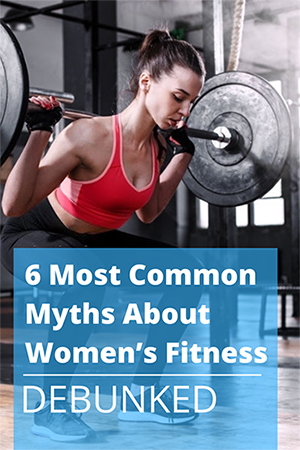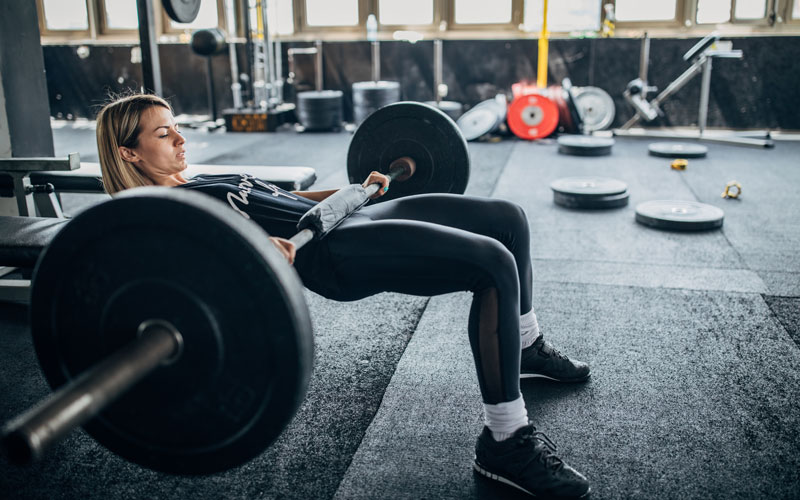6 Most Common Myths About Women’s Fitness Debunked

There are many myths about women and strength training. These misconceptions are not only untenable from a scientific point of view but can also prevent some women from strength training and achieving their training goals. However, we want to change that!
We want to help you women discover the love of training with weights. Because strength training is one of the keys on the way to a feel-good body. Today, we are busting the biggest myths about training and nutrition for women.
Table of Contents
Training myth 1: Women should train differently than men!
This misconception can probably be traced back to the assumption that women can build up just as much muscle mass through strength training as men can. Nevertheless, this is not true. Women have a significantly lower testosterone release than men. Testosterone is a hormone that is produced in the body in both men and women. It stimulates protein metabolism and thus ensures better muscle growth. Even female athletes who train for years can thus progressively increase their weight and become stronger, but they lack the hormones to build muscle mass like a male athlete.
Therefore, fitness for women does not have to be fundamentally different from fitness training for men. Quite the contrary! Workout plans that target strength training can include basic exercises like squats or deadlifts with dumbbells for both genders and offer high intensity that stimulates muscles to grow.
In addition, strength training for women and, of course, for men, offers many other benefits. For example, by building muscle mass you will increase your basal metabolic rate, burn more calories every day (even at rest), thus promoting fat loss and staying fit as a whole. Moreover, you will increase your physical performance thanks to your training sessions. As soon as you see the first results, not only your motivation and fun in training will double. It will also improve your self-confidence and your well-being. Our recommendation: Do not be afraid of heavy dumbbells or training equipment with weights. Do fewer repetitions with heavyweights and focus not only on endurance but also on strength.
Training myth 2: Muscle mass turns into fat when I stop training!
It sounds impossible and it is. With the help of a balanced and healthy diet and progressive strength training (weight increase), you achieve so-called hypertrophy (muscle growth). If you stop training, this process will be reversed. The muscle fibers are not converted into fatty tissue if you do not train, but simply become smaller due to the lack of load – your muscles “shrink”.
As a result, your body composition changes. This means that the muscle mass percentage decreases because training no longer stimulates the muscles. The body fat percentage may increase if you consume more calories than you use.
Our recommendation: If you have to take a longer break from training (vacation, pregnancy, illness), pay more attention to a balanced diet, adjust your calorie intake to your daily activities, stay active in everyday life despite the break and avoid calorie bombs. In this way, you will be able to maintain your muscles despite a lack of training, stay in shape, and avoid gaining weight.

Training myth 3: To see success, I have to train every day!
For women and men alike: regeneration is extremely important for muscle building or body fat reduction. To avoid overtraining symptoms such as frequent fatigue, listlessness, and loss of strength, complete between 48-72 hours of recovery after a workout. Of course, this also depends on your training plan (full body/split program).
The reason for the training breaks is that after a hard training session with the right intensity you have set an appropriate stimulus for your muscles. Your body starts repairing the “destroyed” muscle fibers after the stimulus has been set and prepares them for the next loads. Coordinated nutrition, plenty of sleep, and recovery phases support this process. If you abruptly interrupt or shorten the process of regeneration, you also give your body less time for recovery. The result: increased susceptibility to injury and no optimal muscle growth. However, the rule of the thumb 1-day training, 1-day rest only apply to heavy strength training (deadlifts, squats, bench press, etc.).
Also, don’t fixate on just one part of your body, such as legs and glutes or just abs, but train your entire body. As a beginner, you strengthen each muscle group 2 times a week and as an advanced, you can work your muscles 3 times a week. Between the training days, you can do moderate endurance training on the treadmill or outside in the park.
Nutrition myth 1: Too much protein is unhealthy for me!
Proteins are involved in numerous processes in the body. Among other things, they contribute to the maintenance and development of muscles. Especially during heavy and intensive weight training, it is important to provide the body with sufficient protein building blocks. If you do not cover the increased protein requirement caused by sport, your body will use the supplied proteins for other metabolic processes and will predominantly no longer use them for building up or maintaining your muscles. An adequate protein supply is especially important when you are in a calorie deficit to reduce body fat. If your body then lacks the important protein building blocks, it will predominantly break down muscle instead of the desired body fat.
Our tip: In addition to protein intake, you should continue to do strength training during a diet to send your body the signal that you need the muscles. This will help you to prevent muscle loss as much as possible.
Above all, make sure to choose your protein sources as varied as possible. Turkey, chicken, cottage cheese, soy, fish, nuts, and beans are all possible alternatives. If you have problems covering your daily protein needs, you can also fall back on the convenient component of protein shakes. Especially directly after training, you can supply the muscles with protein with the help of a protein shake.

Nutrition myth 2: Eating more than three times a day leads to weight gain!
You often read that ambitious athletes eat up to 6 meals a day. How does that work without weight gain? The secret is clearly in the calorie balance. At the end of the day, the calorie balance determines your success in building muscle (calorie surplus) or reducing weight (calorie deficit).
Our tip: The individual calorie balance can be easily determined with our calorie calculator.
Meal timing and the number of meals play more of a role in competition and competitive sports. As a recreational athlete, you should primarily orient yourself on the total energy balance of the day and plan your meals accordingly. The advantage of increased meal frequency: You bridge phases of hunger and supply your body and muscles permanently with nutrients. The implementation, especially for women who are very busy at work, is probably more difficult.

Nutrition myth 3: Dietary supplements are only for men!
The basis of your diet should always be to eat a balanced and protein-rich as possible, relying primarily on unprocessed foods. Ideally, you prepare your meals for the day in advance and thus avoid a visit to the canteen or a ravenous appetite attack in the afternoon. Often, in addition to the stress of work and everyday life, there is not enough time to deal intensively with nutrition and to pay attention to an optimal ratio of proteins, carbohydrates, and fats. In this case, dietary supplements can help you on the way to your athletic goal.
A vitamin supplement, for example, helps you to cover your daily requirements of all important vitamins and minerals, in addition to consuming sufficient fruit and vegetables. Above all, the consumption of a protein shake offers you numerous advantages for the optimal nutrient supply of your muscles, as already mentioned above.
Conclusion
Our final recommendation to all our dear female customers: Forget all the myths you have heard so far about women’s fitness. If you want to achieve your feel-good body, you should train with heavyweights, optimize your diet, supplement sensibly with sports nutrition, and then nothing will stand in the way of your physical goals!
- Women’s fitness includes not only endurance training, but also intensive strength training with dumbbells and equipment.
- With the right intensity, a clean technique, the appropriate number of repetitions, and sufficient rest, women’s fitness training favors fat loss and muscle building, increases your self-confidence and well-being.
- Beginners who are not sure if they are doing their fitness training correctly should consult a trainer and be shown the correct technique.
- To support the positive effects of training, it is recommended to meet your daily protein needs and stick to your calorie balance.



